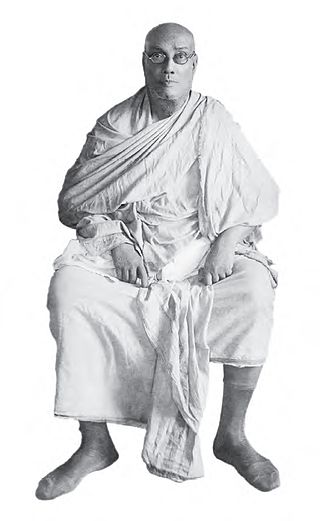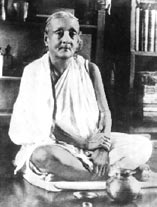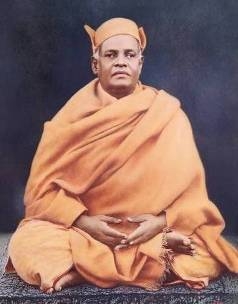
Ramakrishna Paramahansa, also spelled Ramakrishna Paramahamsa, born Gadadhar Chattopadhay was an Indian Hindu mystic and spiritual leader. After adhering to various religious practices from the Hindu traditions of Vaishnavism, Tantra, and Advaita Vedanta, as well as from Islam and Christianity, Ramakrishna proclaimed the world's various religions as "so many paths to reach one and the same goal", thus validating the essential unity of religions. His parable-based teachings espoused the ultimate unity of various religions as a means to enable the realization of the same God. He is regarded by his followers as an avatar or divine incarnation of God.

Sri Sarada Devi, born Kshemankari / Thakurmani / Saradamani Mukhopadhyay, was the wife and spiritual consort of Ramakrishna Paramahamsa, a nineteenth-century Hindu mystic. Sarada Devi is also reverentially addressed as the Holy Mother by the followers of the Sri Ramakrishna monastic order. The Sri Sarada Math and Ramakrishna Sarada Mission situated at Dakshineshwar is based on the ideals and life of Sarada Devi. She played an important role in the growth of the Ramakrishna Movement.
Swami Gambhirananda (1899–1988), born as Jatindranath Datta, was a Hindu sanyasi associated with Ramakrishna Mission. He was born at Sadhuhati in today's Bangladesh. He graduated from Scottish Church College, Calcutta (Kolkata).

Swami Vijnanananda was an Indian monk of Ramakrishna order, born in an upper-class family near Dakshineswar, and was a direct disciple of Ramakrishna. He was an engineer and worked as the District Engineer in the erstwhile State of United Provinces, India. He was a great scholar of Sanskrit with expertise in religio-philosophical works, astronomy, civil engineering etc. He spent considerable time in Allahabad (Prayag) centre of Ramakrishna Math. He became the President of Ramakrishna Mission in 1937. It was under his presidency and direct supervision that the Ramakrishna Temple at Belur Math was constructed and consecrated.

Swami Bhuteshananda was born on 8 September 1901 at Somsar in Bengal Presidency. His premonastic name was Vijay Chandra. His father was Purna Chandra Roy and his mother Charubala Devi. In his student life, he met Jnan Maharaj. Under influence of his and some other spiritual young boys, he started to go to Belur Math frequently and he met many of the direct disciples of Sri Ramakrishna. He graduated from Government Sanskrit College where he mastered Bengali, English and Sanskrit. Due to his visits to the Math, one day he went to the Math to become Monk (Sannyasi), but as his studies was not completed, he was asked to come later. This made him leave his residence and he built a Shiva temple in Baghbazar (Calcutta) and lived there like a renunciate monk, practicing intense Tapasya. He was present during the funeral of Sri Sarada Devi, in December 1920.

Swami Yatiswarananda was a vice-president of Ramakrishna Order, whose headquarter is in Belur Math. He was a disciple of Swami Brahmananda, a brother disciple of Swami Vivekananda and a direct disciple and spiritual son of Ramakrishna. He served in Philadelphia propagating the message of Vedanta. He was the president of Bangalore centre of Ramakrishna Math. He founded an ashrama in Switzerland.

Shuddhananda who was the fifth president of the Ramakrishna Order, was a direct monastic disciple of Vivekananda. He joined the Ramakrishna Math in 1897. He became a trustee of Ramakrishna Math and a member of the governing body of Ramakrishna Mission in May 1903. He also took up the editorship of the Bengali magazine called Udbodhan for sometime. He was appointed as the secretary of the math and the mission in 1927 and as the vice president in 1937. In 1938, he became the president of the order. His tenure was short, as he died in 1938. He is renowned in the literary circles to have translated most of Vivekananda's original works from English to Bengali.

Swami Virajananda, born Kalikrishna Bose, was an initiated disciple of Sarada Devi and the sixth president of the Ramakrishna Order. Born as the son of Trailokyanath Bose and Nishadkalidevi, Virajananda was the first person to join the Ramakrishna Order after the direct disciples of Ramakrishna. In 1897, he was initiated into sannyasa by Vivekananda. From 1899 onward he served in Advaita Ashrama, Mayavati and became its president in 1906. He is recognised as a monastic disciple of Vivekananda.

Ramakrishna Math is the administrative legal organization of the Ramakrishna Order, considered part of the Hindu reform movements. It was set up by sanyasin disciples of Ramakrishna Paramhansa headed by Swami Vivekananda at Baranagar Math in Baranagar, a place near Calcutta, in 1886. India. The headquarters of Ramakrishna Math and its twin organisation, Ramakrishna Mission is at Belur Math.

Balaram Bose was one of the prominent householder disciples of Ramakrishna Paramahamsa. He was the son of Radhamohan Bose. He is often referred in The Gospel of Sri Ramakrishna. Ramakrishna often visited his house and participated in kirtana and other devotional functions. Sri Maa Sarada Devi and some other devotees of the master, including Swami Adbhutananda lived in the house of Balaram Bose after the master's death. He was a great philanthropist and donated regularly to government and civilian organizations.
Ramakrishna (1836–1886) is a famous mystic of nineteenth-century India. Ramakrishna never wrote down the details of his own life. Sources for his life and teachings come from the writings of his disciples and live witnesses. Ramakrishna's recorded sayings mainly come from the last four years of his life.

Sri Ramakrishna Math, Chennai is a monastic organisation for those men who were taught into existence by Sri Ramakrishna (1836–1886), a 19th-century saint of Bengal. The motto of the Ramakrishna Math and Ramakrishna Mission is: "For one's own salvation, and for the welfare of the world". The math in Chennai is the first branch center of the Ramakrishna Order in Southern India. It was established in 1897 by Swami Ramakrishnananda, one of the direct disciples of Sri Ramakrishna. Besides Swami Ramakrishnananda, the Math was visited by Holy Mother Sri Sarada Devi, Swami Nirmalananda, Swami Shivananda, Swami Abhedananda, Swami Premananda, Swami Niranjanananda, Swami Trigunatitananda, and Swami Vijnanananda.

Yogin Ma, born Yogindra Mohini Biswas, was one of the principal female disciples of Sarada Devi, the wife and spiritual consort of the Hindu mystic Ramakrishna. Together with Gopaler Ma, she was a constant companion of Sarada Devi, revered as the holy mother in the monastic order of Ramakrishna.

Swami Yogananda was a disciple of Ramakrishna, the 19th-century mystic. He took his formal initiation from Sarada Devi, the "holy mother" of Ramakrishna Order and spiritual consort of Ramakrishna. He was the first vice-president of Ramakrishna Mission. He belonged to the family of Sabarna Roy Choudhury, an aristocratic family of erstwhile Bengal. He had a very short life, but he played a very important role during the formative years of Ramakrishna Mission. He was also a dedicated and devoted attendant to Sarada Devi during her stay in Calcutta after Ramakrishna's death. He was one of the disciples whom Ramakrishna referred to as "Iswarakoti" or the "ever perfect soul".

Saradananda, also known as Swami Saradananda, was born as Sarat Chandra Chakravarty in 1865, and was one of the direct monastic disciples of Ramakrishna. He was the first Secretary of the Ramakrishna Math and Ramakrishna Mission, a post which he held until his death in 1927. He established the Udbodhan house in the Bagbazar area of Calcutta, which was built primarily for the stay of Sri Sarada Devi in Calcutta, from where he used to publish the Bengali magazine Udbodhan. There he wrote Sri Sri Ramakrishna Lilaprasanga in Bengali, on the life of Ramakrishna, which was translated into English as Sri Ramakrishna, the Great Master. He is believed to be reincarnation of Saint Peter and he allegedly went into Samadhi when he was in the Saint Peter Church and said that "I remembered my past" and wrote in his diary that "Saint Peter again."

Golap Ma was a direct householder disciple of Sri Ramakrishna, the 19th century mystic and saint, and a foremost companion of Sri Sarada Devi, his spiritual consort and the Holy Mother of Ramakrishna Order, along with her other constant companion Yogin Ma. Her real name was Annapurna Devi or Golap Sundari Devi. She was also referred as "grief stricken Brahmani" in the Gospel of Sri Ramakrishna. She played a very important role in the early development of Sri Ramakrishna movement and stayed until her death in Udbodhan, the house where the Holy Mother stayed in Calcutta. She was popular as Golap Ma among the devotees of the Ramakrishna Order.

Gopaler Ma was a devotee and a householder disciple of Sri Ramakrishna, the saint and mystic from Bengal. Her birth name was Aghoremani Devi, but she came to be known as Gopaler Ma among the devotees of Sri Ramakrishna, owing to her intense motherly love for Sri Ramakrishna as "Gopala" or baby Krishna. She was famous for her divine visions of Lord Krishna as a baby and her devotion to the ideals of Sri Ramakrishna. In her later years, she was very close to Swami Vivekananda and Sister Nivedita. She spent the last few years of her life with Sister Nivedita.

Achalananda, popularly known as Kedar Baba, was a direct monastic disciple of Vivekananda and the founder of Ramakrishna Mission Home of Service, in Varanasi. He initially worked as a policeman, but was then influenced by the ideology of Vivekananda.
Vimalananda (1872–1908) was an Indian spiritual writer who was one of the monastic disciples of Vivekananda and an early monk of the Ramakrishna Order. He was involved in the publication of Prabuddha Bharata. He was actively involved in running day-to-day operations of the Advaita Ashrama at Mayavati during the early days of the Ashrama. He also inaugurated the Ramakrishna Math at Ulsoor in Bangalore in 1906. He died in 1908 at the Mayavati Ashrama.
Sri Sarada Math is named after Sri Sarada Devi, the consort of Sri Ramakrishna, and founded on 2 December 1954. Built by a group of eight sadhavis, as per the instructions given by Swami Vivekananda, it serves as a monastic order for women. Headquartered at Dakshineshwar, Kolkata, the organisation has branch centres all over India, in Sri Lanka and Australia. The nuns of this order use the title "Pravrajika" before their ordained name, and are usually addressed as "Mataji" meaning 'revered mother'.
















